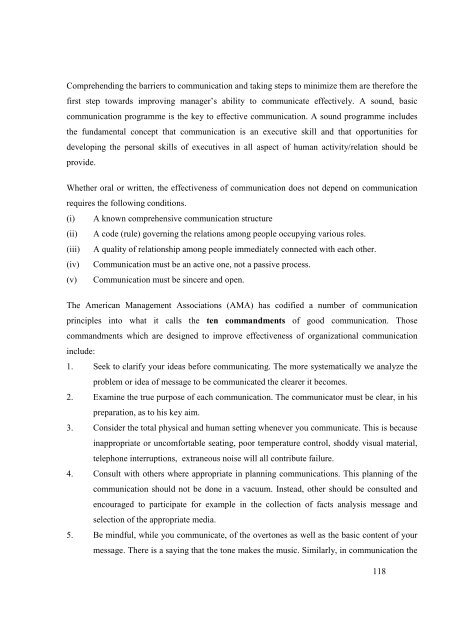HCM 433 MANGEMENT AND ORGANIZATIONAL BEHAVIOUR.pdf
HCM 433 MANGEMENT AND ORGANIZATIONAL BEHAVIOUR.pdf
HCM 433 MANGEMENT AND ORGANIZATIONAL BEHAVIOUR.pdf
You also want an ePaper? Increase the reach of your titles
YUMPU automatically turns print PDFs into web optimized ePapers that Google loves.
Comprehending the barriers to communication and taking steps to minimize them are therefore the<br />
first step towards improving manager’s ability to communicate effectively. A sound, basic<br />
communication programme is the key to effective communication. A sound programme includes<br />
the fundamental concept that communication is an executive skill and that opportunities for<br />
developing the personal skills of executives in all aspect of human activity/relation should be<br />
provide.<br />
Whether oral or written, the effectiveness of communication does not depend on communication<br />
requires the following conditions.<br />
(i) A known comprehensive communication structure<br />
(ii) A code (rule) governing the relations among people occupying various roles.<br />
(iii) A quality of relationship among people immediately connected with each other.<br />
(iv) Communication must be an active one, not a passive process.<br />
(v) Communication must be sincere and open.<br />
The American Management Associations (AMA) has codified a number of communication<br />
principles into what it calls the ten commandments of good communication. Those<br />
commandments which are designed to improve effectiveness of organizational communication<br />
include:<br />
1. Seek to clarify your ideas before communicating. The more systematically we analyze the<br />
problem or idea of message to be communicated the clearer it becomes.<br />
2. Examine the true purpose of each communication. The communicator must be clear, in his<br />
preparation, as to his key aim.<br />
3. Consider the total physical and human setting whenever you communicate. This is because<br />
inappropriate or uncomfortable seating, poor temperature control, shoddy visual material,<br />
telephone interruptions, extraneous noise will all contribute failure.<br />
4. Consult with others where appropriate in planning communications. This planning of the<br />
communication should not be done in a vacuum. Instead, other should be consulted and<br />
encouraged to participate for example in the collection of facts analysis message and<br />
selection of the appropriate media.<br />
5. Be mindful, while you communicate, of the overtones as well as the basic content of your<br />
message. There is a saying that the tone makes the music. Similarly, in communication the<br />
118
















